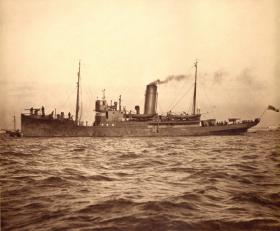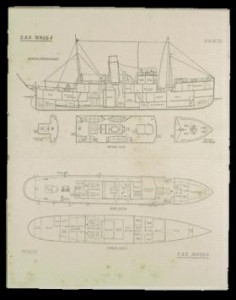TSS Helga II
Published in 20th-century / Contemporary History, Features, Issue 2 (March/April 2010), Volume 18, World War I
The Helga—now ‘HMS’ and classified as an ‘armed auxiliary patrol yacht’—in 1915, after it was taken over by the British Admiralty and armed with guns fore and aft. (National Museum of Ireland)
When I was growing up in the 1980s, my dad would bring me to the National Museum of Ireland every Easter to see the 1916 Exhibition, and we would then walk around Dublin to look at the various areas where the fighting took place. In particular I remember being told of the shelling of Dublin by the Royal Navy’s Helga. I imagined a large battleship sailing up the Liffey with all its guns blazing at Liberty Hall and the GPO.
In fact the Helga II was not a ship of the Royal Navy; it was originally built for the Department of Agriculture in 1908 in Dublin Dockyard and was pressed into war service as an armed yacht during the First World War, serving as an anti-submarine patrol and escort vessel. Like much of the British government’s response to the 1916 Rising, the Helga was rushed into service to make up for the British Army’s lack of artillery. Subsequently the Helga II gained an undeserved reputation for playing an essential part in the Rising. (Most of the damage to Dublin’s city centre was caused by fire, particularly at premises like the Irish Times warehouse and Hoyte’s Druggists and Oil Works, rather than by shelling.)
Prior to the First World War the Department of Agriculture and Technical Instruction used the Helga for fishery patrols and scientific research, including the survey of Clare Island from 1909 to 1911. As can be seen in the drawing (below), the Helga contained a laboratory and was designed as a marine research ship. In 1915 it was taken over by the British Admiralty and became known as HMS Helga, classified as an ‘armed auxiliary patrol yacht’. The ship was armed at the front with a QF twelve-pounder coastal defence gun, crewed by two sailors, with a range of 11,000 metres and a firing rate of fifteen rounds per minute. At the rear there was a smaller three-pounder naval gun, known as a ‘pom pom’.

The Helga was originally designed as a marine research ship and included a laboratory, as indicated on this ship’s drawing. (National Museum of Ireland)
On 25 April 1916 the Helga sailed from Dún Laoghaire to shell Boland’s mill, and on the following day fired over the loop line railway bridge at Liberty Hall. In total the Helga fired only 40 rounds during the Rising, and it is difficult to assess the effectiveness of the fire from her guns. Indeed, two of the ship’s crew refused to fire the guns during the engagement.
After 1923 the Helga was renamed the Muirchu (Seahound) and taken over by the new Irish Department of Agriculture and Fisheries, followed by the Marine and Coastwatching Service in 1939. After being retired, she sank off Tuskar on 8 May 1947 while en route to Dublin to be broken up by the Hammond Lane Foundry Company. In 1951 the Department of Agriculture presented to the National Museum a variety of items associated with the Helga, including the name-plate, pennants, model and ensign. More recently the Irish Naval Service has lent the brass ship’s bell of the Muirchu, which is on display in the Soldiers & Chiefs exhibition, National Museum of Ireland, Collins Barracks. HI
Lar Joye is curator of military history at the National Museum of Ireland (Decorative Arts and History).
Further reading:
J. de Courcy Ireland, The sea and the Easter Rising (Dublin, 1966).
















